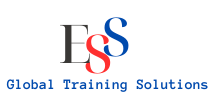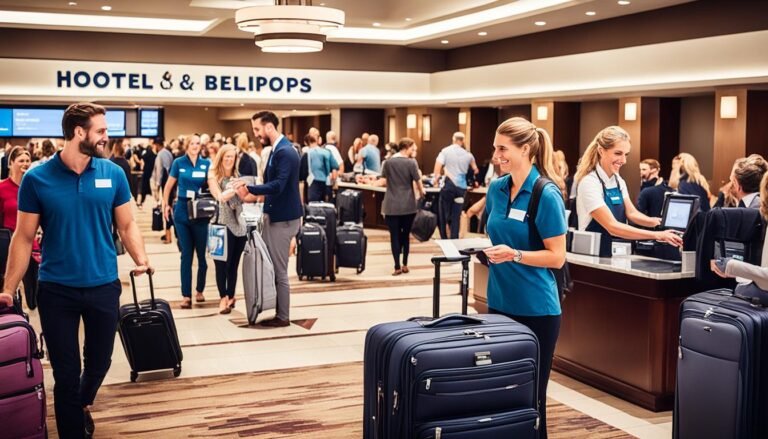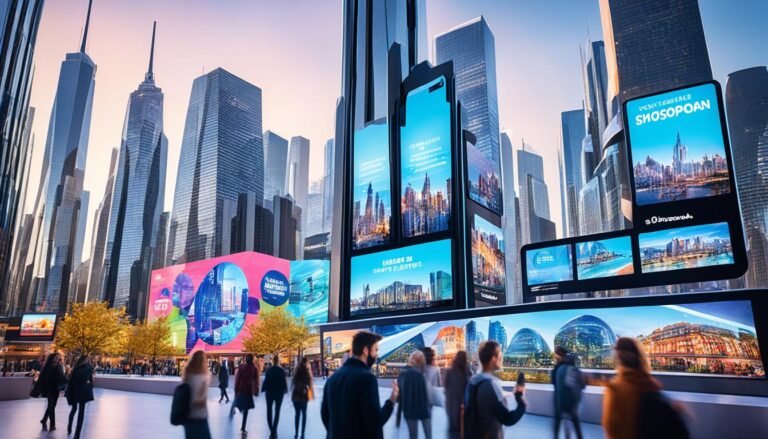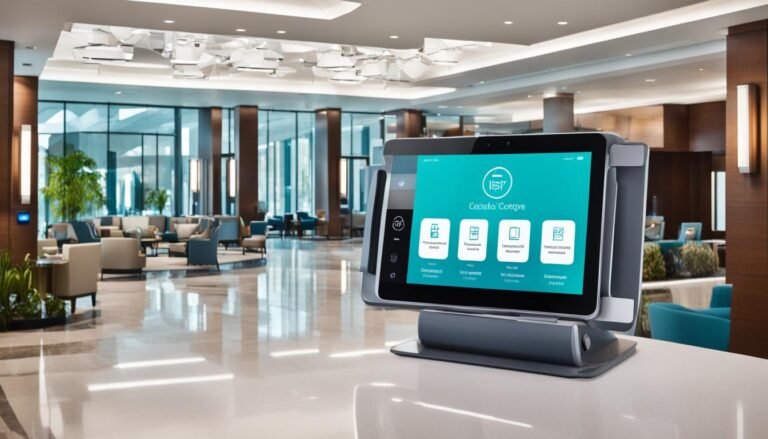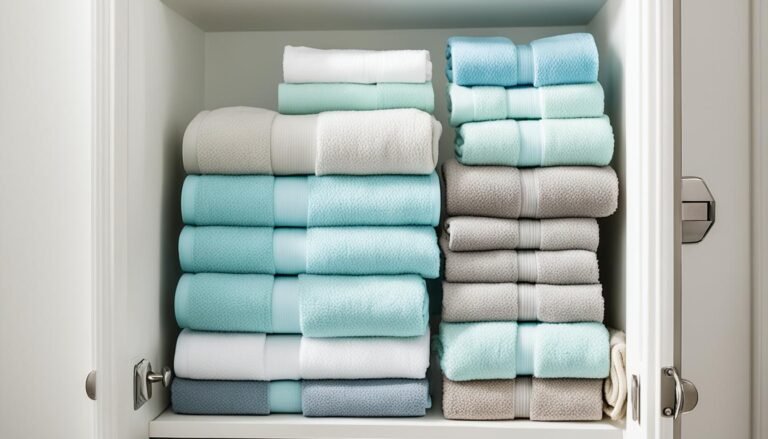Understanding Hospitality Analytics Essentials
Welcome to the world of hospitality analytics! Today, using data well is key to succeed in hospitality. If you run a hotel, manage a resort, or are making a big marketing push, analytics can help a lot.
Imagine running a busy city hotel. You see fewer happy guests and less money, despite great services. You need a real solution, not just guesses, to understand and fix this.
Hospitality analytics is the answer. It uses data to find hidden patterns, make smarter choices, and improve everything from profits to guest joy.
By analyzing data from customers, reviews, and social media, you see what guests really like. This lets you adjust your services and marketing to beat your rivals.
Don’t ignore your data. Using hospitality analytics can open doors to success. Ready to start this exciting journey? Let’s get going!
Key Takeaways:
- Hospitality analytics leverages data to make informed decisions and optimize operations in the industry.
- Analyzing customer interactions, online reviews, and booking data can provide valuable insights.
- Hospitality analytics helps enhance guest experiences and stay ahead of the competition.
- Data-driven decision-making can optimize revenue management and refine marketing strategies.
- Embracing hospitality analytics is crucial for success in the ever-evolving hospitality industry.
Importance of Hotel Key Performance Indicators (KPIs)
In the fast-paced and competitive world of hospitality, keeping your hotel successful is vital. Hotel owners monitor their success through key performance indicators (KPIs). These important metrics show how well a hotel’s running, guiding managers to smart choices for growth.
Hotel KPIs cover a lot, like money made, how well advertising works, and if guests are happy. They also look at if staff are sticking around and how much the business spends on labor. By studying these KPIs, owners can figure out what their hotel does well, where it lacks, and how they can get better. Comparing with other hotels in the area helps see where they stand in the market.
Here are some examples of common KPIs in hotels and what they tell us:
- Occupancy Rate: This KPI shows the percentage of rooms filled in a hotel. A high rate means the hotel is in demand and its marketing is working. But, a low rate could mean they need to change things up.
- Gross Operating Profit (GOP): GOP looks at how profitable a hotel is by subtracting costs from revenue. It’s a good way to find areas where they can save money and make it better. A high GOP means they’re doing well financially.
- Average Daily Rate (ADR): ADR is the average price of a room for a night’s stay. It helps hotels figure out their pricing and if they’re getting the most money they can. By looking at ADR stats, they can decide if they need to adjust their rates.
- Average Length of Stay (ALOS): ALOS tells us how many days people stay in the hotel. It helps them understand guests and plan in a way that keeps rooms full. Hotels can offer deals to make guests stay longer and improve this number.
- Revenue per Available Room (RevPAR): RevPAR combines how much they charge and how full they are to see their overall money-making. It shows if their pricing and marketing are working. Understanding RevPAR helps hotels set their prices right.
These KPIs are key for all hotels to do well. By checking these and other numbers regularly, owners can find strategies to improve. This leads to better business and more earnings.
Keep reading to find out about more hotel KPIs that can make your hotel stand out in a changing market.
Common Hotel KPIs and Their Insights
| KPI | Insights |
|---|---|
| Occupancy Rate | Measurement of demand and marketing effectiveness |
| Gross Operating Profit (GOP) | Evaluation of operational profitability and cost management |
| Average Daily Rate (ADR) | Insights into pricing strategy and revenue optimization |
| Average Length of Stay (ALOS) | Understanding guest behavior and optimizing occupancy |
| Revenue per Available Room (RevPAR) | Overall measure of revenue and marketing effectiveness |
Occupancy Rate (OCC)
Occupancy rate shows how many rooms a hotel has filled. It tells us about the travel desires, times when people go more, and changing trends.
The calculation is simple. You divide the total rooms taken by the total rooms available. Then, times by 100. A high rate means people want to stay and the hotel’s ads work. But, a low rate might signal the need to change prices or how long guests can stay.
By watching the occupancy rate, the hotel knows when to shake up their usual habits.
Travel Demand and Seasonality
The need for rooms changes with the seasons. Hotels use this info to plan and keep their rooms full.
High need times happen around holidays or big events. This is when more rooms get booked. But, when these times pass, filling rooms might be harder. To keep rooms filled, hoteliers change prices and offers to suit the quieter times.
Rate Patterns and Length of Stay Restrictions
How hotels set prices and the rules on how long guests can stay are key. By mixing prices up, hotels can look more appealing.
Rules like how long you can stay can also change how full the hotel is. Having a rule that everyone needs to stay a certain number of nights can keep the hotel busier. This is good for the hotel’s money-making.
Competition Analysis and Pricing Strategy
Watching what other hotels do with their prices is smart. Hotel managers use this to figure out their own prices.
The right pricing can bring in more guests and fill up more rooms. But, it’s also important not to make prices so low you don’t earn enough. It’s about finding that sweet spot between being the best deal and making a profit.
To keep rooms full, having a good plan on prices is key. Think about when people want to visit, who else is out there, and what guests really like.
Changing prices as needed and offering cool deals keep guests coming. By being flexible with costs, hotels can welcome more people during busy times. Also, coming up with fun deals and offers helps fill rooms even when it’s not that busy.
| Occupancy Rate Strategies | Benefits |
|---|---|
| Implementing flexible rate patterns | Attracting guests across different segments and travel patterns |
| Targeting specific customer groups with tailored promotions | Increase occupancy rates during low-demand periods |
| Analyzing and adjusting rates based on competitor analysis | Maintaining competitiveness and market positioning |
| Offering attractive package deals and add-ons | Incentivizing longer stays and increasing ADR |
By making the most of this occupancy data and by being creative, hotels can make more money and keep their rooms busy. This is crucial in the busy world of hotels.
Gross Operating Profit (GOP)
Gross operating profit (GOP) measures how well a hotel is doing financially. It looks at how well the hotel is managing expenses and bringing in revenue. This helps us see if the hotel is making money after covering costs.
Its success is tied to balancing spending with making money. This includes costs like mortgages, staff pay, and buying food and drinks. By watching these costs closely, hotels can make more profit without making guests pay more.
Hotels can make more money by finding new ways to earn and spending less. They can advertise more effectively and make smarter deals to sell more rooms or services. At the same time, they can cut back on spending by finding cheaper suppliers and using less staff.
Examining expenses is key to making these changes. By looking carefully at what the hotel spends on, they can find places to save. This helps them understand which costs are helping or hurting their bottom line the most.
“Achieving a high GOP requires a delicate balance between revenue analysis and cost management. By optimizing revenue streams and effectively managing expenses, hotels can enhance their financial performance and ensure long-term profitability.”
Revenue Analysis for GOP Optimization
To increase GOP, hotels need to look at how they’re making money. They should check where most of their earnings come from and find ways to earn more. This helps them see which parts of their business are doing well.
They should also watch the market to understand what customers want and how much they’re willing to pay. This lets them set prices in ways that make them more money. They look at what other hotels are charging, try different prices, and use data to make better decisions.
Cost Management Strategies for GOP Improvement
Managing costs well is as important as making money. Hotels can save a lot by keeping an eye on their spending. They should find every chance they can to spend less without compromising their service quality.
There are many ways for hotels to spend less, like using less energy, handling their stock better, and getting good deals from suppliers. They can also use new technology to make their operations smoother. Plus, they need to schedule their staff smartly to avoid wasting money on labor.
By doing all this and checking their expenses closely, hotels can get better at managing their money. This helps them become more profitable and efficient in the long run.
Key Takeaways
- Gross operating profit (GOP) is a crucial hotel KPI used to measure a hotel’s profitability and financial performance.
- GOP considers the hotel’s gross operating revenue and deducts the gross operating expenses to calculate the net profitability.
- Hotels can increase GOP by optimizing revenue analysis, implementing cost management strategies, and conducting a thorough review of operating expenses.
- Revenue analysis helps identify growth opportunities, adjust pricing strategies, and optimize revenue streams.
- Cost management strategies involve monitoring expenses, identifying cost-saving opportunities, and implementing measures to reduce unnecessary expenditures.
By focusing on GOP optimization, hotels can enhance their financial performance, improve cost efficiency, and ensure long-term profitability.

Average Daily Rate (ADR)
The average daily rate (ADR) is crucial for hotels. It shows the average cost of a room per night. ADR includes all types of prices a room might have, like special discounts or package deals. It’s found by dividing how much money the hotel made from rooms by the number of rooms sold.
Understanding ADR helps hotel owners manage their prices. They can see if they’re charging too much, too little, or just the right amount. This way, they can pick the best prices to offer, depending on the time of year and what other hotels are doing.
Setting the right prices is key for hotels to earn more money. They need to balance getting the most from a room but also filling as many rooms as possible. By setting smart ADR prices, hotels not only make more money but also attract more visitors.
| Benefits of Analyzing ADR: |
|---|
| 1. Revenue Optimization: Knowing ADR helps hotels set the best prices to make more money and draw in guests. |
| 2. Dynamic Pricing: By watching ADR, hotel owners can change prices quickly to match what customers are looking for. |
| 3. Rate Fluctuations: ADR shows when prices need to be adjusted. This helps hotels keep up with the competition. |
| 4. Competition Analysis: Studying ADR against rival hotels gives insights into how to price your rooms to get ahead. |
Successfully using ADR data is key to hotel success. It helps them make smart pricing decisions, which leads to more income and pulls in more customers. This keeps them strong in the competitive world of hospitality.
Average Length of Stay (ALOS)
The average length of stay is key for hotels to figure out guest habits. This helps them fill rooms better and make more money. ALOS shows how long, in days, people usually stay at a hotel. By studying ALOS, hotels can find ways to make guests stay longer and spend more.
To make guests stay longer, hotels offer special packages. These could include free meals, spa visits, or cheap tickets to fun places. Such offers encourage visitors to extend their trip.
A new trend, called bleisure, mixes work and fun. It’s becoming popular as more business travelers turn part of their trip into a holiday. Hotels now try to meet both work and leisure needs. They offer things like places to work, and easy times to check in or out.
Hotels can also get more guests to stay longer by offering stay-longer discounts. This not only makes their ALOS go up but also keeps more rooms filled. It gives visitors a good reason to stay a bit more.
By using these strategies, hotels can fill up more and earn more. They need to understand what makes guests want to stay longer. Then, they tailor their services and marketing to keep visitors happy.
Revenue Per Available Room (RevPAR)
RevPAR is a key metric in the hotel industry. It is the product of the average daily rate and the occupancy rate. This math gives insights into a hotel’s revenue.
Hotel managers use RevPAR to check their pricing strategies and find ways to earn more. It helps them to see how well they use their money for advertising. This way, they can decide how to grow their business better.
A hotel’s RevPAR depends on how full it is and the price for a room. To make more money, they have to balance these two things well. A good balance brings the best possible revenue.
Making the most of RevPAR is key to a hotel’s success. This means setting prices smartly based on what guests are willing to pay. Good pricing along with other smart strategies can boost a hotel’s income.
Advantages of Analyzing RevPAR:
- Gain insights into a hotel’s overall revenue and profitability
- Evaluate the effectiveness of revenue management strategies
- Identify opportunities for rate optimization
- Evaluate the success of marketing campaigns
- Make data-driven decisions to drive growth and profitability
Knowing about RevPAR helps hotel managers run their business better. It lets them earn more and compete well in the market.
| Advantage | Description |
|---|---|
| Gain insights into a hotel’s overall revenue and profitability | RevPAR shows how well a hotel makes money and covers its costs. Watching this number helps hotels make good financial choices. |
| Evaluate the effectiveness of revenue management strategies | RevPAR checks if a hotel’s money strategies work. It looks at pricing and room availability tactics. Learning from this can help hotels fill up more. |
| Identify opportunities for rate optimization | RevPAR helps find times when prices can be changed to make more money. Hotels can adjust prices to earn as much as they can when it’s busy or slow. |
| Evaluate the success of marketing campaigns | RevPAR sees if ads and marketing are working by checking the money they bring in. This helps hotels choose the best ways to bring in more guests. |
| Make data-driven decisions to drive growth and profitability | By studying RevPAR, hotels can use facts to get better at making money. This helps them pick the best prices, ways to sell rooms, and ads to grow. |
Market Penetration Index (MPI)
Knowing how well a hotel is doing in its market helps it compete better in the tough hotel business. The market penetration index (MPI) is a key number for hotels. It shows how much of the market they have compared to others.
To find the MPI, a hotel’s occupancy is divided by the total occupancy in the market. This answer is then multiplied by 100. If the MPI is over 100%, the hotel is doing better than its rivals in getting guests. But if it’s under 100%, then the hotel is filling fewer rooms than others are.
Looking at the MPI can show hotel owners where they stand. It helps with pricing, understanding what guests want, and how they fare against competitors. This knowledge helps them find ways to get more guests and improve how well they do in the market.
Benefits of Analyzing Market Penetration Index
- Identify market trends and shifts in demand
- Evaluate the effectiveness of pricing strategies
- Analyze competitive positioning
- Identify opportunities for growth
Keeping an eye on the MPI can steer hotels to make smart, data-based choices. This action helps them do better in the market and keep up with their rivals.
Note: The image above illustrates a visualization of how the market penetration index is calculated and its relationship to competitive market share.
Conclusion
Hospitality analytics change the game in hotels, helping workers make choices based on facts. They improve how money is managed and make the guests’ stays better. Using data, people running hotels get to know exactly how well they’re doing. They can keep up with or beat their rivals by making smart choices.
By looking at data closely and planning well, more doors open in the world of hotels. Spotting trends and patterns means places to stay can price things better, run more smoothly, and do better overall. This careful way of working leads to amazing stays for guests. It builds loyalty and brings in more money.
The hotel business is always changing, so it’s vital to keep up with the latest. Better technology in data analytics keeps changing how hotels work. This means there are always new chances to do things better and grow. By using the newest tools and ideas, people in the hotel business can do great things. They can make a real impact and give their guests unforgettable times.
